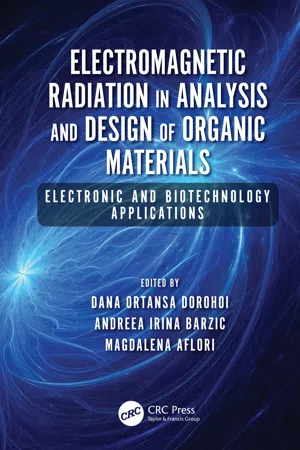CONTENTS
1.1 Introduction
1.2 Theoretical Background
1.3 Results and Discussions
1.4 Conclusions
References
Abstract
The dispersion interactions are dominant in nonpolar solutions; they determine spectral shifts of the electronic absorption bands. The contribution of the dispersion forces can be separated from the total spectral shift recorded in a given solvent in the case of solute molecules with great differences between their polarizabilities in the electronic states participating to the electronic transitions. In this chapter, we discuss the procedure used for obtaining information about the dispersive interactions in some solutions in order to estimate the molecular polarizability in the electronic excited states. This kind of information is useful in quantum mechanical chemistry of the excited molecular states.
1.1 INTRODUCTION
In each moment, a molecule possesses an instantaneous electric dipole moment created by fluctuations in the motion of the valence electrons. Owing to very quick electron motion, the instantaneous dipole moment varies rapidly in time both as value and orientation. In the case of high symmetrical molecules, the average of the instantaneous dipole moment is null; this kind of molecules are considered neutral and nonpolar from the electric point of view.
In condensed media, the electric field created by the instantaneous electric dipole moment of a molecule acts on the neighboring molecules, modifying their dipole moments by induction, polarization, orientation, and so on.
Between nonpolar molecules act dispersion forces whose energies depend both on the molecular ionization potential and polarizability. The dispersion forces arising in a nonpolar molecule due to surrounding temporary dipole moments are the weakest attractive intermolecular forces. The weak interaction between the instantaneous dipole and induced dipole influences the potential energy of the dispersion forces affected by the solute polarizability and also by the molecular mass and shape. The dispersion forces become stronger when the polarizability increases. They also increase with the molecular mass and in the case of the elongated molecules.
All instantaneous interactions influence the molecular energies both in ground and excited electronic states of the solute molecules. The difference between these energies determines the spectral shift of the electronic absorption band related to its position in the solute gaseous phase. This difference depends on the strength of the dispersion interactions of solute in the electronic states responsible for the absorption phenomena in nonpolar solutions.
1.2 THEORETICAL BACKGROUND
The existence of the dispersive forces between the nonpolar molecules cannot be explained by classical theories. The first scientist who explained the dispersive interactions in a satisfactory theory was London (Murgulescu and Sahini 1978, Hodges and Stone 2000) in 1933. He has shown that, when two nonpolar molecules u and v are at a distance ruv small enough that the long-range forces do not tend to zero, their instantaneous dipole moments μu and μv interact by attractive forces. The electric field around them modifies the temporary distribution of the valence electronic cloud in each molecule, by inductive actions. The new induced dipole moments have opposite senses and determine an intensification of the attractive forces between the molecules u and v.
The intensity of the dispersive forces varies in function on both intermolecular distance and polarizability of the spectrally active (solute) molecules in electronic states participating to the absorption phenomenon (Reichardt 2003, Parasegian 2006).
In London theory, the dispersive interaction energy wuv between two molecules u and v is expressed by
The parameters from relation (1.1) have the following significance:
wuv is the energy due to dispersive interactions in the isolated molecular pair u–v;
hv0u = I(u) and hv0v = I(v) are ionization potentials of the two interacting molecules determined by the highest frequencies v0u and v0v from the molecular electronic absorption spectra;
α(u) and α(v) are the molecular polarizabilities of the molecules u and v, respectively;
ruv is the intermolecular distance.
Relation (1.1) expresses the dispersion ...
